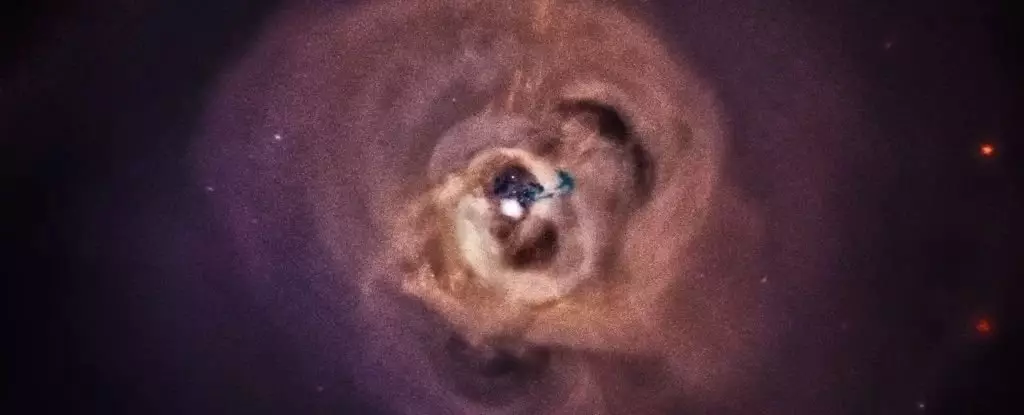In a remarkable achievement bridging science and art, NASA has transformed mysterious sound waves emanating from a supermassive black hole, located an astounding 250 million light-years from Earth, into an auditory experience. This black hole resides within the core of the Perseus cluster of galaxies, a region noted for its stunning celestial phenomena. The transformation of these inaudible cosmic sounds into something perceivable to the human ear has generated intrigue and wonder, underscoring the complexities of our Universe.
The audio clip, released in 2022, features sounds that have been transposed by a mind-boggling 57 to 58 octaves to bring them within the realm of human hearing. The resultant effect is a haunting symphony that evokes eerie feelings akin to both melancholy and anger. For listeners, this transformation is not merely an auditory experience; it is a bridge into the realm of astrophysics, revealing to us the whispers of the cosmos that are otherwise undetectable.
First and foremost, it is important to clarify a common misconception about sound in the vacuum of space. While space is predominantly a vacuum that hampers the transmission of sound waves, regions such as galaxy clusters possess copious amounts of gas, enabling the propagation of acoustic vibrations. The sounds recorded from the Perseus cluster are a manifestation of those vibrations permeating through intergalactic gas and plasma, which the scientists detected in 2003—a breakthrough that initially revealed the existence of cosmic sound waves.
The lowest note extracted from the black hole is an astonishing B-flat, significantly below the auditory threshold of humans. This note has a frequency spanning a mind-bending 10 million years, while conventional low frequencies heard by the human ear occur within a one-twentieth of a second range. The sonification process involved extracting sounds radially from the black hole and altering their pitches, leading to the chilling yet captivating auditory experience that now captivates audiences.
The significance of these sound waves extends beyond mere curiosity—they play a pivotal role in our understanding of galaxy clusters and their evolution. The gas and plasma surrounding supermassive black holes are inherently dense and hot, creating a conducive environment for sound waves to propagate. This phenomenon becomes relevant in energy transport; as sound waves traverse through the intracluster medium, they carry energy that contributes to heating the surrounding gas.
This heating mechanism is crucial as it influences star formation processes within galaxies. Sound waves can trumpet changes across vast cosmic scales, thereby affecting the overall dynamics within galaxy clusters over an extended timeline. The relationship between acoustic waves and the temperature of intracluster gas sheds light on the intricate workings of the cosmos, illuminating the ways in which sound could shape the future of galactic structures.
The creation of sounds from astronomical data isn’t limited to the Perseus black hole. The famed supermassive black hole M87*, which garnered global attention following its first direct imaging through the Event Horizon Telescope, has similarly been rendered audible through sonification. By employing various instruments—ranging from the Chandra X-ray Observatory for X-ray data to the Hubble Space Telescope for optical images—scientists could convert visual data into sound.
Interestingly, this multi-faceted approach opens a new avenue for data interpretation in astrophysics. By varying the pitch based on the frequency of the data, astronomers can gain new insights and reveal hidden relationships between cosmic processes that may not be evident through traditional observational methods.
Through sonification, scientists are not merely generating sound; they are weaving a deeper connection between human experience and the astronomical phenomena surrounding us. This innovative method creates an opportunity to explore celestial landscapes in a sensory manner, inviting a broader audience to appreciate the complexities of the Universe.
Ultimately, the collaborative efforts to transpose sounds from the depths of space into the realm of human hearing underscore a vital intersection of science and art. The haunting notes extracted from supermassive black holes resonate with audiences, drawing them into an appreciation of both the scientific principles behind the phenomena and the artistic beauty of cosmic sound. As we continue to explore the enigmatic universe, the transformation of data into auditory experiences may inspire future generations of astronomers and artists alike to unravel the mysteries of existence, one note at a time. In experiencing the sound of these celestial giants, we become attuned not only to the Universe’s past but perhaps to its future as well.

